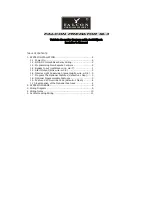
2.
SOURCES OF CARBON MONOXIDE
Inside your home, appliances used for heating and cooking are the most likely sources of CO. Vehicles running in attached
garages can also produce dangerous levels of CO. CO can be produced when burning any fossil fuel, such as gasoline, propane,
natural gas, oil and wood. It can be produced by any fuel-burning appliance that is malfunctioning, improperly installed, or
not ventilated correctly, such as:
z
Automobiles, furnaces, gas ranges/stoves, gas clothes dryers, water heaters, portable fuel burning space heaters and
generators, fireplaces, wood-burning stoves and certain swimming pool heaters.
z
Blocked chimneys or flues, back drafts and changes in air pressure, corroded or disconnected vent pipes, loose or cracked
furnace exchangers.
z
Vehicles and other combustion engines running in an open or closed garage, attached or near a home.
z
Burning charcoal or fuel in grills and hibachis in an enclosed area.
3.
CONDITIONS THAT CAN RESULT IN TRANSIENT CO SITUATION IN THE HOME:
The following conditions can result in transient CO situations:
z
Excessive spillage or reverse venting of fuel-burning appliances caused by outdoor ambient conditions, such as, wind
direction and/or velocity, including high gusts of wind, heavy air in the vent pipes (Cold/humid air with extended periods
between cycles).
z
Negative pressure resulting from the use of exhaust fans.
z
Simultaneous operation of several fuel-burning appliances competing for limited internal air.
z
Vent pipe connections vibrating loose from clothes dryers, furnaces, or water heaters.
z
Obstructions in, or unconventional, vent pipe designs which can amplify the above situations.
z
Extended operation of unvented fuel-burning devices (range, oven, fireplace, etc.).
z
Temperature inversions which can trap exhaust gases near the ground.
z
Vehicle idling in an open or closed garage, or near a home.
To be safe, know the possible sources of CO in your home. Keep fuel-burning appliances and their chimneys and vents in good
working condition. Learn the early symptoms of exposure, and if you suspect CO poisoning, move outside to fresh air and get
emergency help. Your first line of defense is an annual inspection and regular maintenance of your appliances. Contact a
licensed contractor or call your local utility company for assistance.
4.
SYMPTOMS OF CO POISONING
35 ppm
The maximum allowable concentration for continuous exposure for healthy adults in any 8 hour period
200 ppm
Slight headaches, fatigue, dizziness, nausea after 2-3 hours
400 ppm
Frontal headaches within 1-2 hours, life threatening after 3 hours
800 ppm
Dizziness, nausea and convulsions within 45 minutes. Unconsciousness within 2 hours and death within 3 hours
1600 ppm
Headache, dizziness and nausea within 20 minutes. Death within 1 hour.
6400 ppm
Headache dizziness and nausea within 1-2 minutes
The following symptoms related to CO POISONNING and are to be discussed with ALL members of the household:
Mild Exposure:
Slight headache, nausea, vomiting, fatigue (often described as “flu-like” symptoms)
Medium Exposure:
Severe throbbing headache, drowsiness, confusion, fast heart rate.
Extreme Exposure:
Unconsciousness, convulsions, cardio respiratory failure, death.
Many cases of reported CARBON MONOXIDE POISONING indicate that while victims are aware they are not well. They
become so disoriented they are unable to save themselves by either the building or calling for assistance. Yong children and
household pets are typically the first affected.
5. IMPORTANT SAFEGUARDS


























